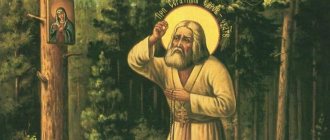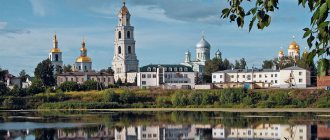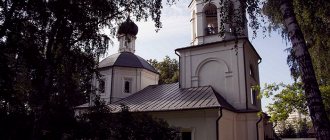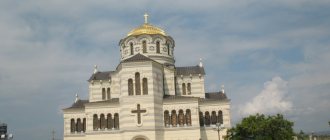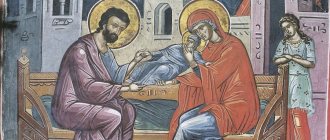The first destiny of the Mother of God on Earth
Ancient Iveria, present-day Georgia, is the first inheritance of the Mother of God on Earth.
After the Ascension of the Lord Jesus Christ, the apostles gathered in the Upper Room of Zion, where the sacrament of Communion was established, and cast lots: to which country each of them would go. The Most Holy Theotokos wished to take part in the Gospel preaching, Iberia became Her lot... However, the Lord, having promised that He would not reject Her lot and would not leave Her people without participation in Heavenly good, commanded His Mother to send Her miraculous image there, and to bless the holy Apostle for the sermon Andrew the First-Called.
According to legend, the Apostle Andrew preached three times in Iberia, enlightening many of its cities and villages, he founded an episcopal see here, ordained a bishop, priests and deacons.
Spread of Christianity in Iberia
In the city of Atskuri, near the modern city of Akhaltsikhe, the apostle resurrected the son of a widow who had died on the eve of his arrival. Having witnessed this miracle, the inhabitants of that area received Baptism. It was here that the Apostle Andrew left the miraculous icon of the Most Holy Theotokos, which, based on the name of these places, has since been called Atskurskaya, its memory is still celebrated on August 28, AD. Art.
It is known that the holy apostles Matthias, who was buried here in Apsara - now Gonio near Batumi, and Simon the Canaanite, who was buried in Nikopsia, preached the gospel in Iveria. Also, the most ancient sources mention the preaching of the holy apostles Bartholomew and Thaddeus in Eastern Georgia. But they learned about the Incarnate Messiah on this blessed land even before the apostolic sermon. The first heralds of the good news in Iberia were the Mtskheta Jews, who came here in Old Testament times after the capture of Jerusalem by Nebuchadnezzar II (597 BC) and settled in Mtskheta, where already at the beginning of the new era they spoke about the Nativity of the Infant God.
The first Georgian saint
Mtskheta rabbi Elioz, the same high priest Anna, in the 30th year of the 1st century. asked in a letter to come to Jerusalem to participate in the trial of Jesus Christ. Elioz’s mother, who came from the family of the high priest Elijah, begged her son not to take part “in the blood of Christ.” According to legend, this Jewish believer heard the sound of a hammer as they hammered nails into the hands of the Savior of the world, and at that very moment she died with the words: “Farewell from now on, the kingdom of the Jews, which killed the Savior who came in the flesh and became the enemy of the Creator God.”
At the request of his sister, as well as the mother of a believer in the Savior, Sidonia Elioz bought the Chiton of the Lord from the warrior who received it by lot cast at the Cross (see prophecy Ps. 21:19), and brought it to Mtskheta. Having heard the story about the death of Christ, and taking the shrine, Sidonia hugged it to herself and betrayed her soul to the Lord. Heaton was never taken from the hands of this first Georgian saint, and she was buried with him. A miraculous cedar grew at the resting place of Saint Sidonia. Until the time of the arrival of the main preacher, Saint Equal-to-the-Apostles Nina, in Iveria, this place remained secret...
Seraphim-Diveevo Monastery
The portions of the Most Holy Theotokos on Earth are places of special gratitude, created by the chosen for the glory and command of the Queen of Heaven.
Description
The Holy Trinity Seraphim-Diveevo Monastery is one of the largest convents for women, created by the will of the Most Pure One in the village of Diveevo near the Nizhny Novgorod region (bordering the Republic of Mordovia and located on the coast of the Vichkinza River). The Orthodox center is revered by Christians as the 4th “earthly Destiny of the Most Holy Theotokos,” and according to the prophecy of St. Seraphim of Sarov, it will subsequently acquire the status of the only women’s monastery in the world.
Story
The beginning of the formation of the monastery was subsidized in the 18th century, when the wealthy Kiev landowner Agafya Melgunova, suddenly widowed, decided to preserve the purity of her widowhood by taking monastic vows. Having become a nun of the Kiev-Florovsky Monastery, Alexandra once during a midnight vigil saw the face of the Mother of God, who ordered her to leave the monastery further to the north of Rus' and carry the word of God until the moment the Earthly Queen showed her her place.
Having turned to the monks of the Kiev-Pechersk Lavra for advice, Alexandra received recognition of the truth of her knowledge and set off to wander around Rus'. During the journey from Murom to the Sarov wasteland, mother stopped to rest in the village of Diveevo. Here the Mother of God appeared to her for the second time, ordering her to build a monastery in this place, the inhabitants of which would forever remain under her patronage and protection.
At the end of the 18th century. With Mother Alexandra's own money, the foundation of the future church was laid in Diveevo, and 6 years later it was lit.
On the eve of her death, Mother Alexandra entrusted her godly work to the young hierodeacon Seraphim. And subsequently, the Mother of God herself appeared to the future Saint Seraphim of Sarov, ordering him to continue building the monastery and take care of the sisters. Thanks to the participation of Father Seraphim, the Mill community was eventually added to the Kazan Church, inhabited only by selected sisters who abandoned worldly life and their own will in favor of tireless work and prayers. Father Seraphim became the guardian angel of the residents of the monastery, calling them orphans and constantly caring for their well-being.
In 1842, the community acquired the status of Serafimo-Diveevskaya.
Pilgrimage
The modern Holy Trinity Seraphim-Diveevsky Monastery is a combination of 4 beautiful cathedrals: Kazan, Trinity, Transfiguration and Annunciation. In the Trinity Monastery where the remains of Father Seraphim of Sarov found peace.
16 km from the monastery complex in the village of Tsyganovka there is the source of St. Seraphim, rumored to have healing powers, as well as a source named after the venerable founder of the monastery, Alexandra.
The spiritual center of the monastery is considered to be the groove of the Most Holy Theotokos - the path that the Queen of Heaven personally measured with her belt, and along which she walks around her final destiny every night. The ditch was created during the lifetime of Seraphim of Sarov.
Services are held daily in the Church of the Holy Trinity Seraphim-Diveevsky Monastery.
You can get to the shrine from Nizhny Novgorod:
- by bus leaving from the train station every hour starting at 8:00;
- by boat departing from the river station located in the historical part of the city;
- by train passing through the city of Arzamas to Diveevo station;
To accommodate pilgrims, there are 15 buildings available here, subject to advance booking, and providing housing from beds to comfortable apartments.
Services here are held in 4 churches and begin at 5:15 am. In addition to attending the liturgy, you can also book a sightseeing walking tour of the monastery and the surrounding area.
The earthly inheritance of the Most Holy Theotokos is a blessed land given to the Queen of Heaven by her son and under the special protection of the Virgin Mary. The temples and monasteries founded here by order of the Almighty bear the title of Orthodox shrines and are carefully protected from encroachment, and also allow pilgrims to enjoy the special grace, peace and solitude given to people by the Almighty.
Martyrs of the Georgian land
The fact that Christian communities existed in Ancient Iberia in the 1st–3rd centuries after the Nativity of Christ is evidenced by archaeological and toponymic data. Already in the 2nd century AD. In the chronicles, among the Christian peoples, the Ivers - Georgians - are mentioned. Although at this time Christians here were persecuted: at the beginning of the 2nd century, Saint Sukhoi and 16 of his warrior-companions from noble Georgian families suffered martyrdom. Their memory is celebrated on April 28. All of them at one time were nobles, but having learned about Christ and having accepted Baptism, they left a life full of pleasures at court and, secluded to pray in the mountains, became ascetics. But the pagan king did not tolerate such disgrace for his way of life, and all the ascetics were brutally killed.
In general, martyrdom runs like a red thread throughout Georgian history. Moreover, for the Ibelians, the confession of Christ from time immemorial was identified with the struggle for the identity of the people, and later for their statehood.
When in 1226 Khorezm Shah Jalal-ed-din captured the capital of Georgia, Tbilisi, he ordered the dome of the Zion Cathedral of the Assumption of the Mother of God to be removed and placed his throne there. Icons of the Savior and the Blessed Virgin Mary were placed on the bridge. Tbilisi residents were ordered to walk along them, desecrating the images with spitting. Those who refused were immediately beheaded and thrown into the river. On that day, 100,000 Christians in Tbilisi forever adorned themselves with martyr's crowns. They are commemorated on November 13th.
In 1386, Tamerlane, having captured the Kvabtakhevsky monastery, wanting to abuse and humiliate the brides of Christ, forced them to sing and dance. For her refusal, the martyr, along with other residents of Georgia devastated by the conqueror, were burned alive in the cathedral church of the Most Holy Theotokos. The memory of the Kvabtakhev martyrs is celebrated on April 23.
In 1616, during the invasion of Shah Abbas, 6,000 monks of the David Gareji Monastery, who had just celebrated the Resurrection of Christ, asked the executioners to complete the Easter service. Their memory, like that of the Kvabtakhev martyrs, is celebrated on April 23. Two of them hid at first, but seeing with what grace the Lord covered the martyrdom, they themselves jumped out of their hiding places to meet the triumph of martyrdom for Christ. Didn’t they say to each other and to the executioners before departing to the Lord: Christ is Risen!
It is believed that the Russian people, who did not know strong persecution throughout their Christian history, were allowed to enter the 20th century. That is why, although there were repressions in Georgia during the Soviet years, they were not so severe. His Holiness and Beatitude Catholicos-Patriarch of All Georgia Ilia II, who has headed the Georgian Orthodox Church since 1977, even once called the Tbilisi Church of the Holy Blessed Prince Alexander Nevsky “a branch of the Glinsk Hermitage” - it was here that they labored after the repeated closure of this illustrious monastery during the atheistic years her elders.
In Tbilisi, many of them are laid to rest - these are those who are now glorified as saints: Metropolitan Zinovy (Mazhuga), in the schema Seraphim, Schema-Archimandrite Andronik (Lukash), Schema-Archimandrite Seraphim (Romantsov), as well as the one whose glorification is awaited by the entire Orthodox people - Schema-Archimandrite Vitaly (Sidorenko). We warmly love the Russian, as well as the Georgian, people and the Georgian holy fool archimandrite of our times - the Monk Gabriel (Urgebadze).
Pilgrimage to the places of exploits and to the graves of these most beloved Orthodox saints of our days is a special blessing for those who themselves would like to inherit at least a part of their ascetic spirit, just as they inherited it from their predecessors. This country, blessed with the promises of God and the patronage of the Most Holy Virgin Mary Herself, could not, in its reciprocal love for God, show lesser fruits of heroism and self-denial: throughout the centuries and right up to the present day.
Mount Athos
The inheritance of the Most Holy Theotokos on Earth is a lot that fell to the Queen of Heaven or was chosen by her of her own free will for preaching and establishing the ideals of the Christian worldview.
Description
Mount Athos is the second earthly Destiny of the Virgin Mary, located in the northeast of Greece, on the island of Chalkidiki. It is here, at an altitude of 2033 m above sea level, that numerous monasteries inhabited by hermit monks are located.
Thousands of pilgrims come here every year, but only men are allowed to visit this sacred place for any Christian. Women are not allowed to enter here and the most they can do is enjoy the sight of dolphins frolicking around, accompanying boats with tourists during a boat trip.
Story
Mount Athos received the status of the second Domain of the Most Holy Theotokos during her earthly life. It was here that, fleeing the persecution of King Herod, during a strong storm the ship on which the Virgin Mary and Saint John the Theologian sailed was carried. The initial place of visit of the Mother of God was supposed to be the island of Cyprus, where four-day-old Lazarus, resurrected by her son, served as bishop, but a sudden storm carried the ship to the foot of Mount Athos, inhabited by pagans far from Christian ideals.
Seeing God's providence in this, the Mother of God went ashore and proclaimed the gospel teaching to the people who met her. Amazed by the beauty of the land that greeted her, the Mother of God turned to her son with a request to grant her an earthly inheritance, and having received permission, with the help of the power of preaching and numerous miracles, she converted the pagans of Athos to Christianity. Sailing to Crete, the Virgin Mary gave her blessing to those gathered, promising to protect them before her heavenly son.
Subsequently, the Queen of Heaven repeatedly brought her ascetics to Athos, among whom was St. Peter, considered the founder of the Athos Monastery.
In 963, an ancient monastery, the Great Lavra, was built on the mountain, and in 972, by agreement with Byzantium, the Holy Mountain was recognized as an autonomous state. Over time, the number of residents here only increased, and by the 16th century, about 40 thousand monks already lived in 20 large monasteries of Athos.
To this day, the autonomous status of Mount Athos remains unchanged. Residents of monasteries are also considered citizens of Greece, but in fact are governed by their own Monastic Administration, created in accordance with the Charter. The Greek state is represented here by the governor.
For many millennia, the way of life of the monks has not changed. Now about 1,700 monks live here, leading a rather strict, ascetic lifestyle. Neither women nor many types of domestic animals are allowed entry to Mount Athos. This was done due to the fact that, according to legend, the Virgin Mary herself chose the mountain as her place of rest from other females.
Pilgrimage
Today, Mount Athos is considered one of the favorite places of pilgrims, but it can only be reached by sea on a ferry departing on weekdays at 6:30 am. Only men are allowed to enter the territory, and before visiting, mandatory pre-registration is required at the Pilgrim Administration located in Thessaloniki. The registration request must be submitted no later than six months before the date of the proposed trip, and only 10 believers are allowed to enter the monasteries per day. In total, there are 20 monasteries on the territory, in each of which visitors can spend the night no more than once.
Open to the public:
| Dohiar Monastery | Situated on the western bank and has a watchtower, making it look a bit like a border fort. |
| Xenophon | Built in the 10th century. by the Byzantine nobleman Xenophon and, according to tradition, received his name. |
| St. Panteleimon Monastery | Possessing a majestic view and inhabited exclusively by Russian-speaking monks. |
| Simonopetra | Nicknamed "Eagle's Nest" due to its location on a mountainside directly above the sea. |
| Dionysiatus | The storage place of the most ancient Athonite icon, dating back to the 7th century. The location of the monastery, located on the southern point of the island and considered the territory of hermits, is also interesting. |
| Great Lavra | The oldest and largest of the monasteries, founded in 693 by Saint Athanasius at the foot of Mount Athos. Now it is home to more than 100 monks. The famous library is also stored here, including more than 5,000 various handwritten publications. |
| Caracal | The main cathedral church of the monastery, located 200 m above sea level. |
| Stavronikita | The monastery was founded in the 10th century and occupies 15th place in the Svyatogorsk hierarchy. |
| Pantocrator | The fortress with loopholes, divided into 2 courtyards, was built at the end of the 14th century by the military leader Alexy and the pious John. The monastery was built in honor of the Transfiguration of the Lord, and was painted in 1538. |
| Vatoped | The oldest and richest of the monasteries on the Holy Mountain, which flourished in a small bay located in the northeastern part of the island. |
| Esphigmen | One of the oldest Athonite monasteries, dating back to the 5th century and containing many Christian relics. The monastery is also known for its library, numbering 8,000 books and 400 various handwritten publications. |
| Kareya | The capital of Athos and the center of its political life |
Saint Nina - patroness of Iberia
Christianity has become widespread in Iberia since the 4th century, when the young native of Cappadocia Nina arrived here. Her parents completely devoted themselves to serving the Church, and the girl was raised by the pious elder Niofora. Since childhood, having heard about the Robe of the Lord, kept in Mtskheta, the little Christian was eager to venerate the shrine. Before she got here, the Mother of God appeared to her in a dream and, handing her a cross made of a vine, blessed her to preach in Her inheritance - in Iberia. Waking up, Nina tied a strand of her hair around the cross, which symbolized consent and dedication of her life to the entrusted service. The “Cross of St. Nino,” distinguished by slightly downward sides of the crossbar, became a symbol of the Georgian Orthodox Church. The Mother of God protected the girl-apostle. On the way to Iveria, Nina avoided many dangers. Her companions were brutally tortured by the servants of the Roman emperor-monster Diocletian.
Arriving in Georgia, Nina settled near the northern border of the city of Mtskheta, setting up a hut for herself in a blackberry tree. Now the Samtavro convent is located here, and next to the still growing blackberry bush, a small church of St. Nina was built. Here she healed and preached.
One day, Queen Nana herself came to her, and the Equal-to-the-Apostles healed her of a serious illness. She told her husband about everything, and at first the king even intended to kill the healer who dared to convert his people to another faith, but he immediately became blind, began to pray in vain to his pagan gods, and then appealed to “God Nino,” promising to accept Christianity if saved. , and at the same moment he received his sight. This is glorified among the saints, like his believing wife, King Mirian. In the presence of Saint Nina, he confessed Christ and sent a letter about his desire to receive Baptism to Saint Queen Helena and her son, Saint Emperor Constantine the Great.
Thus, Bishop John, priest Jacob and a deacon were delegated to Iveria, whose name history has not preserved. First, the king and his court were baptized, and then at the confluence of the Aragvi and Kura rivers the entire people were baptized. This happened in 326. To this day, on October 1, the Georgian Orthodox Church celebrates Svetitkhovloba - every year on this day His Holiness and Beatitude Ilia II performs a mass Baptism in the waters of Aragvi and Kura.
The memory of Equal-to-the-Apostles Nina is celebrated in Iveria twice a year on January 27 and June 1 - these days are revered as great holidays. With her blessing, crosses were erected on the mountains where pagan idols had previously stood: in Mtskheta, where the Jvari Temple was later built on this site, as well as on Mount Thoti, the site of the conversion of King Mirian, and in the city of Ujarma.
Georgians also fell in love with Equal-to-the-Apostles Nina’s cousin, St. George the Victorious. In all European languages, Georgia is called Georgia. Tradition says that there used to be a church or chapel for him on all the hills of Iberia. And how many of these consecrated hills there are in Georgia, from which breathtaking views open up and fill the heart with the praise of the Creator, you will find out already on the spot, having visited this holy country... The pilgrim will gladly help in organizing your trip!
Kiev-Pechersk Lavra
The portions of the Most Holy Theotokos on Earth are special places given to her by the heavenly son, a place for prayer and rest from the hustle and bustle, as well as a refuge for all those seeking salvation.
Description
The Kiev Pechersk Lavra is the third earthly inheritance of the Most Pure One, located in the very center of Kyiv on the high right bank of the Dnieper and occupies two hills separated by a hollow descending to the waters of the river. The entire territory of the first Orthodox monastery of Kievan Rus occupies an area of 30 hectares, but pilgrims are attracted here not only by the monastery itself, but by its caves, which became the basis for the construction of the temple. Now the Kiev-Pechersk Lavra includes: 41 buildings, including a religious complex and buildings of economic importance.
The modern complex has 2 parts:
- Upper Lavra, with the National Kiev-Pechersk Historical and Cultural Reserve located in it.
- Lower Lavra, with the Orthodox Church.
Both parts are allowed for free visits and, unlike other religious places, do not differ in traditional Christian strictness, and in 1992 the complex was included in the list of monuments protected by UNESCO.
Story
The Kiev-Pechersk Lavra became the earthly inheritance of the Most Holy Theotokos thanks to the actions of the Venerable monk Anthony. Born in Kievan Rus, he wished to join the ranks of the Athonite monks, but after taking monastic vows, the Virgin Mary appeared to the abbot of the monastery, Theoktistus, ordering him to send Anthony to his homeland, where he should carry the word of God. Anthony returned to Kyiv in 1013. Here, near the village of Berestovo, he dug a cave for himself, where he not only lived, but also preached the Holy Gospel.
After 6 years, Anthony returned to Athos, but after the accession of Yaroslav the Wise to the princely throne, the Mother of God again appeared to Abbot Theoktistus, ordering him to send the monk back to Rus', giving him the blessing of the Holy Mountain. In 1028, Anthony appeared in Kyiv again, this time, digging himself a cave on the coast of the Dnieper. Here he continued his charitable deeds.
Gradually, Christians began to visit him, many of whom subsequently took monastic vows. A little later, a monastery was built next to the caves - the Kiev Pechersk Lavra. Initially, the life of the monks was concentrated in caves, but as the number of brethren grew, the need arose to build first a wooden and then a stone monastery.
Pilgrimage
The modern Kiev Pechersk Lavra is a huge religious building, most of the buildings of which serve as Orthodox landmarks. So the complex includes:
Assumption Cathedral
The main temple complex and the oldest structure, founded in 1073. Due to the death of St. Theodosius, construction of the temple began only 2 years later and was completed by 1079. There is a legend that the width and length of the temple are made up of 20 and 30 gold “belts” presented to the monks by the Varangian Shimon.
Upon completion of the construction, visiting architects decorated the building with mosaics and frescoes, which, unfortunately, have not survived to this day.
Now the cathedral is considered a unique structure of the 12th century. The church is crowned by a dome, about 9 m in diameter with marble naves.
Over the years of its existence, the cathedral was destroyed twice (in the 13th and 20th centuries), and was finally restored only in the early 2000s.
Refectory church and chamber
The most notable building of the 19th century, built on the site of the former monastery dining room. Due to lack of space, it was expanded, additionally adding to it the Church of Saints Anthony and Theodosius of Pechersk. Here, under the refectory hall, is the grave of P. Stolypin.
During the war, the refectory building was destroyed, but was subsequently successfully restored.
Great Lavra Bell Tower
The 6th tallest bell tower in the world dates back to the 18th century. The diameter of the first tier here is about 8 m, and approximately 3.5 tons of gold leaf were used to cover the dome.
Trinity Gate Church
The central entrance to the Kiev Pechersk Lavra, dating back to the 12th century and subsequently reconstructed several times. The entire interior space of the temple here is divided by massive columns, each of which contains colorful frescoes with various biblical scenes.
In the center of the church there is a wooden 3-tier iconostasis, decorated with gold, whose wooden frames are made using the hand-carved technique.
Caves of the Kiev Pechersk Lavra
The main attraction of the complex, consisting of near caves stretching over a length of 400 m and going to a depth of 10-15 m and distant ones - with a length of 300 m at a depth of 20 m. Here are the cells of St. Anthony and Abbot Theodosius, as well as a functioning church and a tomb where the incorruptible relics of the saints rested.
In addition to the cathedral, guests of the complex can also visit the museums located here.
The religious-secular complex is open to the public every day (except January 1):
- Lower Lavra - from 6:00 to 20:00;
- Upper Lavra - from 9:00 to 19:00.
The entrance ticket costs 15 hryvnia.
You can visit the complex either independently or as part of a tour. Since the area here is huge and located on hilly terrain, guests are advised to wear comfortable shoes. Women are also required to cover their heads with a headscarf when entering temples.
